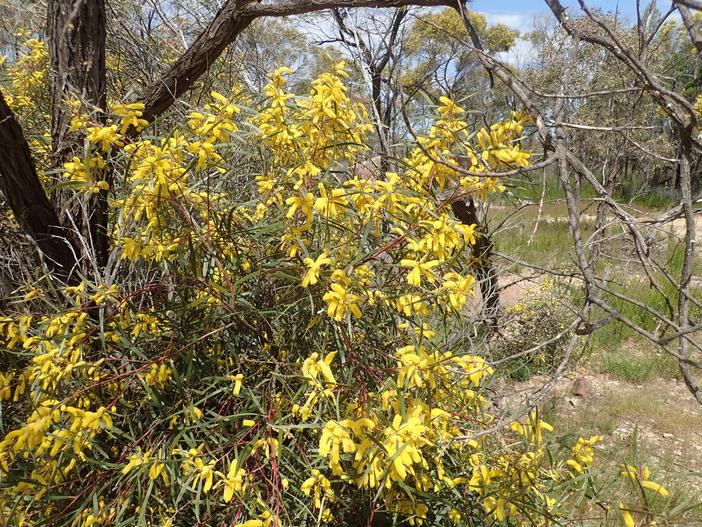Currawang
(Acacia doratoxylon)
Currawang (Acacia doratoxylon)
/
/

Stitchingbushwalker
CC BY-SA 4.0
Image By:
Stitchingbushwalker
Recorded By:
Copyright:
CC BY-SA 4.0
Copyright Notice:
Photo by: Stitchingbushwalker | License Type: CC BY-SA 4.0 | License URL: https://creativecommons.org/licenses/by-sa/4.0 | Uploader: Stitchingbushwalker | Publisher: Wikipedia Commons














Estimated Native Range
Summary
Acacia doratoxylon, commonly known as Currawang, Lancewood, Spearwood, or Coast Myall, is a perennial shrub or small tree native to the dry sclerophyll forests and woodlands of eastern and southeastern Australia. It typically grows 10 to 26 feet tall, occasionally reaching a maximum height of 33 feet. The species exhibits an erect to spreading habit and is characterized by dark greyish-brown to black corrugated bark. Its phyllodes (leaf-like structures) are narrow and leathery, and from August to November, it produces showy golden-yellow flowers in cylindrical heads. These are followed by glabrous, papery seed pods that are 2 to 4 inches long. Currawang is often found in association with Eucalyptus and Callitris woodlands, on rocky ridges, and sandy plains.
Currawang is valued for its ornamental flowers, land rehabilitation, and erosion control properties. It is a nitrogen-fixing species, which enhances soil fertility, making it beneficial for ecological restoration projects. The wood has been traditionally used by Indigenous Australians to make spears, and the foliage serves as emergency fodder during droughts. In cultivation, it prefers full sun to partial shade, well-drained soils, and is drought-tolerant once established. It is not commonly used in urban planting but can be considered for native plant gardens and reforestation efforts.CC BY-SA 4.0
Currawang is valued for its ornamental flowers, land rehabilitation, and erosion control properties. It is a nitrogen-fixing species, which enhances soil fertility, making it beneficial for ecological restoration projects. The wood has been traditionally used by Indigenous Australians to make spears, and the foliage serves as emergency fodder during droughts. In cultivation, it prefers full sun to partial shade, well-drained soils, and is drought-tolerant once established. It is not commonly used in urban planting but can be considered for native plant gardens and reforestation efforts.CC BY-SA 4.0
Plant Description
- Plant Type: Shrub, Tree
- Height: 15-20 feet
- Width: 3-6 feet
- Growth Rate: Moderate
- Flower Color: Yellow
- Flowering Season: Winter, Spring
- Leaf Retention: Evergreen
Growth Requirements
- Sun: Full Sun
- Water: Low
- Drainage: Medium, Fast
Common Uses
Border Plant, Drought Tolerant, Erosion Control, Low Maintenance
Natural Habitat
Native to dry sclerophyll forests and woodlands of eastern and southeastern Australia
Other Names
Common Names: Lancewood, Currawang, Spearwood
Scientific Names: , Acacia doratoxylon, Acacia doratoxylon var. doratoxylon, Racosperma doratoxylon,
GBIF Accepted Name: